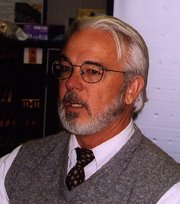
Note to attendees: Dr. David Hood is one of the chief organizers of the conference. He will be working with Dr. Chris Pollitt to provide an educational and entertaining debate on the process of acute laminitis on Friday evening. Billed as "The Trial of the Century", this is a not-to-be-missed event! The article below will give you some insight into Dr. Hood's work on laminitis.
COLLEGE STATION, TEXAS--One of America's foremost researchers into all aspects of laminitis, David Hood, DVM, PhD, is overseeing construction of the new Hoof Project hospital and research center in the grassy hills outside College Station, where he teaches equine anatomy and physiology at Texas A&M University.
Many horses donated to The Hoof Project for research suffer from chronic laminitis, Cushings syndrome, or other types of long-term lameness.
Among Dr. Hood's most recent achievements is a reliable hoof biopsy test, which allows veterinarians to extract samples of hoof wall tissue for study under a microscope. Since most laminitis damage occurs in the toe area, a sample punched at the mid-toe will show how badly the delicate laminae have been stretched, distorted, or even destroyed. Once the extent of damage is known, a horse's recovery plan can be made more realistically. The biopsy site is kept clean and quickly heals.
The damage of laminitis is a heavy weight on Dr. Hood's mind, but his recent studies also show that horses suffer from secondary sources of pain. Changes in stance, posture, and gait affect tendons and ligaments in the legs, and joint angles may be altered, leading to arthritis. Even back and neck pain can develop in horses that are standing in abnormal positions for long periods of time. The fact that a horse has laminitis may cause other co-existing lamenesses, such as ringbone, collateral ligament injuries, sheared heels, or navicular damage to be overlooked.
Hood is developing protocols to separate pain from laminitis from other types of pain in the foot. He uses a pressure-sensitive Tekscan floor mat to monitor how laminitic horses bear weight, shift weight, and how they place their feet when walking. Using Dr. Hood's emerging data, horses may be simultaneously treated for multiple problems that were not discernible because of the dramatic mask of laminitis pain.
Note: Some of this text may have appeared in the article "Laminitis Battle Stations" in Practical Horseman magazine.
